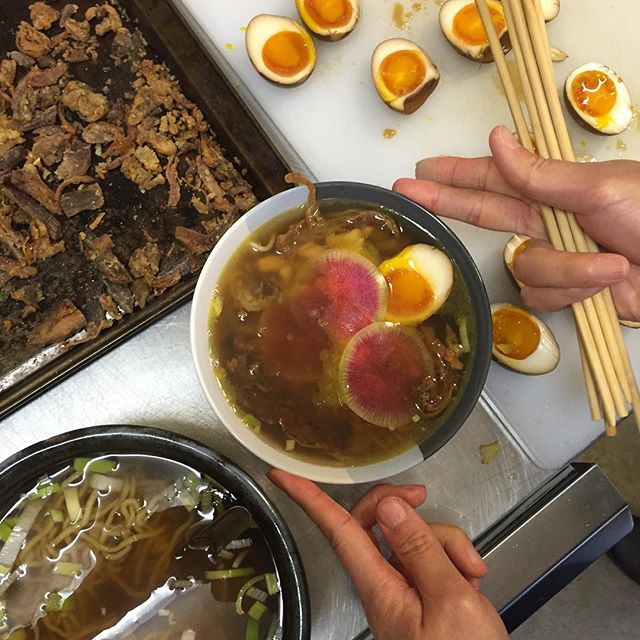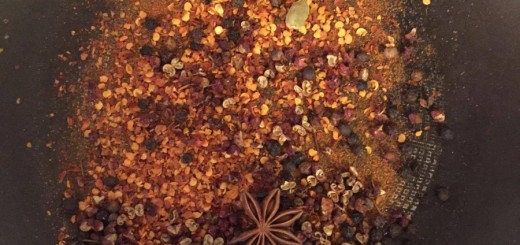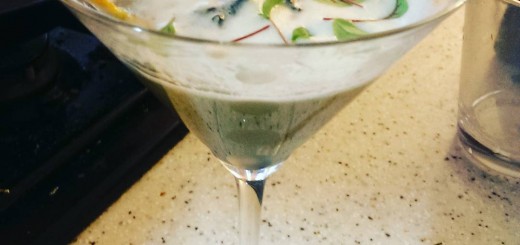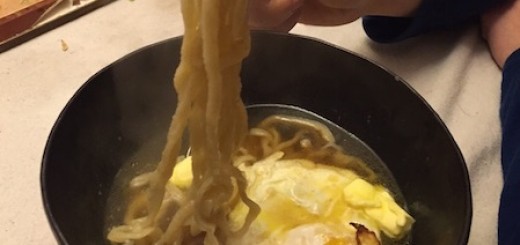Chicken Ramen Lunch in the Longhouse
Making this recipe teaches how to balance flavors in a broth. If the taste points of a star are sweet, sour, bitter, umami and salt, as Barb Stuckey teaches us in Taste What You’re Missing then having some emphasis on more than one of these points will give a more interesting and balanced broth. The star shape or flavor balancing of this broth emphasis Umami and salt, balanced by light sweetness and acidity. Getting a delicious savory broth is the most important part of this soup.
Ingredient list:
-For The Stock-
1 whole chicken and optional extra chicken feet (peeled)
pot of boiling water
leeks
radishes
ginger
parsnips
kombu seaweed
onion
carrot
smoked barley
bonito flakes
soy sauce
fish sauce
-For The Noodles-
baked baking soda
semolina flour
all purpose flour
-For the Special egg-
water
fresh eggs
sherry vinegar
soy sauce
sugar
Preparing components:
-Sliced leeks and thinly sliced radishes-
Slice and reserve. It helps to use a mandolin slicer for this.
-Chicken Stock
In a large pot start with one entire chicken covered with cold water. Add a 4 inch chunk of ginger, one big piece of kombu, and the ends of all the other vegetables (parsnip, leeks, and radish) to the water. Then add roughly chopped onion and carrot, sprinkle with salt. Add a handful of smoked barley then cook all day at a simmer avoiding a full boil. Do not stir the broth to keep vegetables, etc from deteriorating, keeping your broth nice and clear. Strain the broth through a mesh strainer.
-Adding Bonito Flakes
In a medium pot full combine 1 cup of Bonito Flakes to 6 cups of your chicken broth. Bring this to a boil and let it boil for 30 seconds before taking it off the heat. Let it sit for 10 minutes and strain it back into the rest of the chicken broth.
-Seasoning the Broth-
This broth was seasoned with the sherry and soy sauce mixture from the special eggs, rice vinegar, fish sauce, and salt. Season the broth with these ingredients by adding a little and then tasting before you add more. You can’t take salt out very easily. It needs more of the soy sauce than the other seasonings but it also takes a decent amount of vinegar to be balanced. Go light on the fish sauce because the Bonito flakes already added a bit of fish flavor. Add the sliced leeks before you begin cooking noodles.
-Roasted parsnips-
Dice the parsnips into bite size pieces, and then place them on a baking sheet. Coat with oil and sprinkle with salt and pepper. Bake at 175 degrees Celsius for 15-20 minutes. Remove when golden brown on the outside and tender/soft on the inside. Reserve for later use.
–Crispy chicken skin garnish-
After four hours remove the chicken carcass from the stock, pull off the thigh meat and skin, return the remaining carcass to the simmering stock. Dice the skins and thigh meat into bite size pieces. Then coat with flour and pan fry the chicken in a very hot pan and a small amount of oil (we used fat from the chicken but vegetable or canola oils would be fine). Once golden brown and crispy, place the fried skin onto a wire cooling rack so it doesn’t get soggy. Season with salt and pepper and reserve.
–For the noodles-
combine 4 tsp of the baked soda with 100 grams of warm tap water. Stir until it dissolves then add 100 grams of cold tap water. In a separate bowl, combine 200 grams of semolina flour and 200 grams of AP flour.
Add the alkaline water to the flour and stir and mash into a stiff dough. Knead the dough for 5 minutes. The folks at Lucky Peach predict, “You will curse and sweat.” let it rest covered for 10 minutes. Knead for 2 more minutes, then let it rest for an hour wrapped up in the fridge.
Cut the dough into 5 or 6 pieces and roll it through a pasta rolling machine. We rolled it through the widest setting (#1) then folded it over on itself and rolled it through the same one. Then progress through the roller settings to #4 before running it through the cutter part. Toss the noodles with lots of flour to keep them from sticking together. Tossing the noodles with whole wheat or semolina will work better. If you’re going to store them overnight, spread the noodles out in a ziplock bag and put it in the fridge.
Cook the noodles to order, they only need to boil in water for a minute or two. Then rinse them in cold water to halt the cooking process before serving
-Special egg–
In a large, wide mouth jar combine 6 tablespoons of warm water, 1 tablespoon of sugar, ¾ cup of soy sauce and 2 tablespoons of sherry vinegar. Bring a small pot (big enough to boil about 6 eggs) of water to a low boil to make sure the eggs don’t crack. We got a nice semi-runny yolk at about 6 minutes and 10 seconds, keep in mind the size of your eggs though–ours were pretty small. With a slotted spoon, remove the eggs from the boiling water and place them into a bowl of ice-water to cool them down quickly. Next, peel the eggs in the ice water to help separate the membrane from the egg, making it easy to peel. Carefully put the peeled eggs into the mixture of water, sugar, soy sauce and sherry vinegar, there should be enough for the eggs to be submerged in the mixture. Let these eggs sit for at least 2 hours but can soak for up to 3 days. One handy trick to cut these perfectly is to use sewing thread and cut the egg in half vertically. This recipe was derived from online sources Food 52 and Genius Recipes.
Plating:
Assembly:Cook the noodles, they only need to boil in water for a minute or two. Then rinse them in cold water to halt the cooking process. Put a serving of noodles in the bowl. Ladle a serving of broth into each bowl and add a portion of parsnips. Place three thinly slice radishes in the center of the bowl. Slice the special egg in half vertically and place on one side of the bowl. Then sprinkle the crispy chicken skins in a circle around the remaining space
A Note on Ramen Alkaline Noodles
We adapted our recipe from Harold Mcgee’s technique featured in the New York Times and measurements from Lucky Peach Magazine. This called for baked baking soda to make the noodles alkaline which affects their flavor and behavior in ways that are not fully understood. We know that most foods tend towards the acidic side of neutral, while a few foods get special flavor from alkaline processing. These foods include Pretzels, Corn Tortillas, and Ramen noodles. As for What alkalinity does to the flavor of a food and why, McGee suggests that the hydroxyls in alkaline things react with larger molecules especially fats and oils and change their flavor and texture.
McGee explains that baking baking soda at 250-300 degrees fahrenheit for an hour changes it from sodium bicarbonate to sodium carbonate. Sodium carbonate has no protons which means it pulls protons from water molecules in food and leaves free hydroxyls that react with fats and other large molecules in our food.
Bibliography:
Chang, David. “Homemade Ramen Noodles.” Lucky Peach. N.p., 12 Jan. 2015. Web. 13 Jan. 2016. <http://luckypeach.com/recipes/fresh-alkaline-noodes/>.
Mcgee, Harold. “For Old-Fashioned Flavor, Bake the Baking Soda.” The New York Times. The New York Times, 14 Sept. 2010. Web. 13 Jan. 2016. <http://www.nytimes.com/2010/09/15/dining/15curious.html?_r=0>.
Genius Recipes “Momofuku’s Soy Sauce Eggs Recipe on Food52.” Food52. N.p., 12 May 2015. Web. 13 Jan. 2016. <http://food52.com/recipes/35930-momofuku-s-soy-sauce-eggs>




